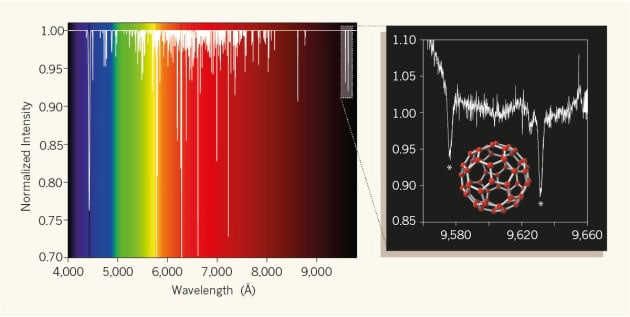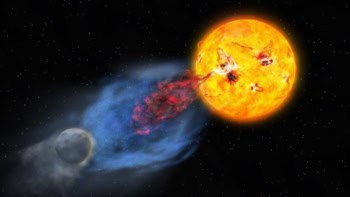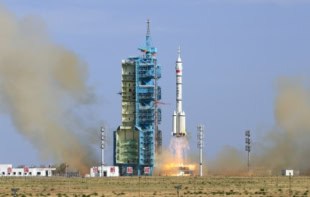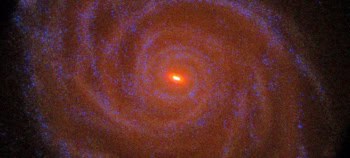
It is official: buckminsterfullerene molecules, or “buckyballs”, exist in our galaxy – the Milky Way. The latest, unambiguous confirmation, from researchers at the University of Basel in Switzerland, not only confirms a 20-year-old prediction but also indicates that C60 might be ubiquitous in space.
It is nearly a century ago now that scientists first detected certain features in starlight from the Milky Way. Since then, these features, called diffuse interstellar bands (DIBs), have also been recorded in the spectra from the interstellar medium of other galaxies. However, researchers have not yet identified which chemical molecules are responsible for producing these bands.
In 1994 astrophysicists Pascale Ehrenfreund and Bernard Foing, who are now at George Washington University in the US and the European Space Agency, reported on two bands at 9632 Å and 9577 Å. These bands were thought to come from C60+ molecules because C60+ absorbs light at these wavelengths.
Band match
Now, thanks to new spectroscopy experiments on bound C60+ and helium at 5.8 K (the temperature of interstellar space), a team led by John Paul Maier in the Department of Chemistry at the University of Basel has found that the light absorption features of C60+ indeed match those of the two bands identified more than two decades ago. The researchers obtained their result by comparing the light absorption spectra of stars through diffuse interstellar clouds and the electronic spectrum of C60+.
“Scientists have known about DIBs for more than 90 years now and around 400 of them are currently listed in the literature,” explains Maier. “However, until our work on C60+, none of these bands had been unequivocally identified.”
The fact that a molecule as complex as C60+ is present in the interstellar medium (in fact, the two C60+ DIBs have also already been observed in protoplanetary nebula) indicates that it may be commonplace in space and stable in very hostile environments, Maier adds.
Maier notes that it has taken his team 20 years to measure the spectrum of C60+ in the gas phase. “Our motivation to undertake this study started in 1993, when we obtained the light absorption spectrum of C60+ in solid neon at 6 K,” he says. “The following year Foing and Ehrenfreund found the two DIBs that had wavelengths close to those in our laboratory measurements and suggested that the absorbing molecule (or ‘carrier’) in these DIBs was C60+. Confirming this theory has been no easy task and has required measuring the molecule’s absorption in the gas phase and at low temperature.”
Ultracold RF trap
The researchers developed a technique that allows them to trap ions with different masses in a radio frequency trap at ultralow temperatures. “Using such a process, we can trap thousands of C60+ ions,” explains Maier. However, because it is not possible to directly measure the absorption of such low concentrations of C60+, the team bound it with helium. “We knew from experiments that we had already carried out on small ions some time before that the helium has only a very tiny influence on the C60+ and that the absorption spectrum we measured would essentially be that of C60+,” he says.
They proved their assumption by attaching two helium atoms to each C60+ molecule and showed that any remaining shifts in the absorption bands were less than 0.2 Å – an error figure that is much more precise than that required when analysing astronomical data.
The team measured the light absorption of the C60+-He complex by exciting a few hundred of the species in the ion trap with a laser. When excited, the helium atoms are removed. By quantifying the decrease in the number of C60+-He+ species in the trap, Maier and colleagues were able to obtain the absorption spectrum of the C60+ alone. “When we then compared the wavelengths of the laboratory-measured absorption with the astronomical data, we found a perfect agreement – thus proving that C60+ is indeed at the origin of the interstellar absorption, and that it exists in space.”
Circle of life
Their results suggest that C60 is probably produced in dying stars that “push out” the molecule into the planetary nebula and into diffuse interstellar clouds, he adds. “The ionizing radiation present here means that the C60 predominantly exists as the positively charged ion C60+. Ultimately the diffuse clouds provide seeds for new stars to form and the C60+ is thus recycled back into them,” says Maier. Astrophysicists will now ask themselves whether C60 and its ion are in fact responsible for the formation and presence of smaller molecules identified in the next ‘evolutionary’ phase of diffuse clouds – dense clouds.”
Carbon cousins?
In recent years, astronomical observations have found DIBs across the entire optical range, meaning that they abound in space. Indeed, they have recently been spotted in the Milky Way’s satellite galaxies, known as the Magellanic Clouds, and in other galaxies. The carrier C60+ molecules may consequently be crucial in the formation of organic material across the universe.
The Basel researchers say that they will be trying to find out if any of these DIBs are directly related to derivatives of C60+, such as those containing metals and other elements. “This possibility has already been put forward by the British scientist Harry Kroto (who was awarded the Nobel Prize for Chemistry in 1996 – shared with Robert Curl and Richard Smalley) shortly after C60 was discovered,” explains Maier. “As mentioned, experiments on this topic are very challenging and it took us 20 years to obtain the data we present on C60+ alone. It is now up to the next generation of scientists to continue with this work. I am due to become emeritus professor in a year’s time, so do not have much time left to have a go at solving such fascinating problems – another life is required!” he says.
The research is published in Nature
- A version of this article first appeared on nanotechweb.org



